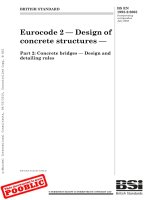Bsi bs en 61391 2 2010
Bạn đang xem bản rút gọn của tài liệu. Xem và tải ngay bản đầy đủ của tài liệu tại đây (1.35 MB, 42 trang )
BS EN 61391-2:2010
BSI Standards Publication
Ultrasonics — Pulse-echo
scanners
Part 2: Measurement of maximum depth
of penetration and local dynamic range
BRITISH STANDARD
BS EN 61391-2:2010
National foreword
This British Standard is the UK implementation of EN 61391-2:2010. It is
identical to IEC 61391-2:2010.
The UK participation in its preparation was entrusted to Technical Committee
EPL/87, Ultrasonics.
A list of organizations represented on this committee can be obtained on
request to its secretary.
This publication does not purport to include all the necessary provisions of a
contract. Users are responsible for its correct application.
© BSI 2010
ISBN 978 0 580 58266 0
ICS 17.140.50
Compliance with a British Standard cannot confer immunity from
legal obligations.
This British Standard was published under the authority of the Standards
Policy and Strategy Committee on 31 July 2010.
Amendments issued since publication
Amd. No.
Date
Text affected
BS EN 61391-2:2010
EUROPEAN STANDARD
EN 61391-2
NORME EUROPÉENNE
April 2010
EUROPÄISCHE NORM
ICS 17.140.50
English version
Ultrasonics Pulse-echo scanners Part 2: Measurement of maximum depth of penetration
and local dynamic range
(IEC 61391-2:2010)
Ultrasons Scanners à impulsion et écho Partie 2 : Mesure de la profondeur
maximale de pénétration et de la plage
dynamique locale
(CEI 61391-2:2010)
Ultraschall Impuls-Echo-Scanner Teil 2: Messung der maximalen
Eindringtiefe und des lokalen
Dynamikbereichs
(IEC 61391-2:2010)
This European Standard was approved by CENELEC on 2010-04-01. CENELEC members are bound to comply
with the CEN/CENELEC Internal Regulations which stipulate the conditions for giving this European Standard
the status of a national standard without any alteration.
Up-to-date lists and bibliographical references concerning such national standards may be obtained on
application to the Central Secretariat or to any CENELEC member.
This European Standard exists in three official versions (English, French, German). A version in any other
language made by translation under the responsibility of a CENELEC member into its own language and notified
to the Central Secretariat has the same status as the official versions.
CENELEC members are the national electrotechnical committees of Austria, Belgium, Bulgaria, Croatia, Cyprus,
the Czech Republic, Denmark, Estonia, Finland, France, Germany, Greece, Hungary, Iceland, Ireland, Italy,
Latvia, Lithuania, Luxembourg, Malta, the Netherlands, Norway, Poland, Portugal, Romania, Slovakia, Slovenia,
Spain, Sweden, Switzerland and the United Kingdom.
CENELEC
European Committee for Electrotechnical Standardization
Comité Européen de Normalisation Electrotechnique
Europäisches Komitee für Elektrotechnische Normung
Management Centre: Avenue Marnix 17, B - 1000 Brussels
© 2010 CENELEC -
All rights of exploitation in any form and by any means reserved worldwide for CENELEC members.
Ref. No. EN 61391-2:2010 E
BS EN 61391-2:2010
EN 61391-2:2010
-2-
Foreword
The text of document 87/400/CDV, future edition 1 of IEC 61391-2, prepared by IEC TC 87, Ultrasonics,
was submitted to the IEC-CENELEC parallel vote and was approved by CENELEC as EN 61391-2 on
2010-04-01.
Attention is drawn to the possibility that some of the elements of this document may be the subject of
patent rights. CEN and CENELEC shall not be held responsible for identifying any or all such patent
rights.
The following dates were fixed:
– latest date by which the EN has to be implemented
at national level by publication of an identical
national standard or by endorsement
(dop)
2011-01-01
– latest date by which the national standards conflicting
with the EN have to be withdrawn
(dow)
2013-04-01
Annex ZA has been added by CENELEC.
__________
Endorsement notice
The text of the International Standard IEC 61391-2:2010 was approved by CENELEC as a European
Standard without any modification.
In the official version, for Bibliography, the following notes have to be added for the standards indicated:
IEC 60601-1:2005
NOTE Harmonized as EN 60601-1:2006 (not modified).
IEC 61161:1992
NOTE Harmonized as EN 61161:1994 (not modified).
__________
BS EN 61391-2:2010
EN 61391-2:2010
-3-
Annex ZA
(normative)
Normative references to international publications
with their corresponding European publications
The following referenced documents are indispensable for the application of this document. For dated
references, only the edition cited applies. For undated references, the latest edition of the referenced
document (including any amendments) applies.
NOTE When an international publication has been modified by common modifications, indicated by (mod), the relevant EN/HD
applies.
Publication
Year
Title
EN/HD
Year
IEC 61391-1
2006
Ultrasonics - Pulse-echo scanners Part 1: Techniques for calibrating spatial
measurement systems and measurement of
system point spread function response
EN 61391-1
2006
IEC 62127-1
2007
Ultrasonics - Hydrophones EN 62127-1
Part 1: Measurement and characterization of
medical ultrasonic fields up to 40 MHz
2007
BS EN 61391-2:2010
–2–
61391-2 © IEC:2010(E)
CONTENTS
INTRODUCTION.....................................................................................................................6
1
Scope ...............................................................................................................................8
2
Normative references .......................................................................................................8
3
Terms and definitions .......................................................................................................8
4
General requirement....................................................................................................... 13
5
Environmental conditions................................................................................................ 13
6
Equipment and data required.......................................................................................... 14
6.1
6.2
7
General ................................................................................................................. 14
Phantoms .............................................................................................................. 14
6.2.1 Phantoms required .................................................................................... 14
6.2.2 Phantom for maximum depth of penetration ............................................... 14
6.2.3 Phantoms to estimate local dynamic range ................................................ 15
6.3 Test equipment for measuring local dynamic range ............................................... 15
6.4 Digitized image data .............................................................................................. 17
Measurement methods ................................................................................................... 19
7.1
System sensitivity: maximum depth of penetration................................................. 19
7.1.1 Scanning system settings .......................................................................... 19
7.1.2 Image acquisition ...................................................................................... 19
7.1.3 Analysis..................................................................................................... 20
7.2 Local dynamic range ............................................................................................. 22
7.2.1 Scanning system settings .......................................................................... 22
7.2.2 Measurement method ................................................................................ 22
7.2.3 Type II testing for measuring local dynamic range ..................................... 23
7.2.4 Estimating local dynamic range using backscatter contrast ........................ 24
Annex A (informative) Phantom for determining maximum depth of penetration ................... 26
Annex B (informative) Local dynamic range using acoustical test objects............................. 28
Bibliography.......................................................................................................................... 35
Figure 1 – Arrangement for measuring local dynamic range using an acoustic-signal
injection technique ................................................................................................................ 16
Figure 2 – Arrangement for measuring local dynamic range using an acousticallycoupled burst generator ........................................................................................................ 17
Figure 3 – Image of the penetration phantom ........................................................................ 20
Figure 4 – Mean digitized image data value vs. depth for the phantom image data
(A(j)) and for the noise image data (A'(j)) .............................................................................. 21
Figure 5 – Digitized-image data vs. attenuator setting during local dynamic range
measurements using acoustic signal injection ....................................................................... 23
Figure 6 – Image of phantom with inclusions (circles) ........................................................... 24
Figure 7 – Ensemble-average mean pixel value vs. backscatter contrast of inclusions. ......... 25
Figure A.1 – Phantom for maximum depth of penetration tests.............................................. 26
Figure B.1 – Possible arrangement of reflectors for determining local dynamic range ........... 29
Figure B.2 – Displayed intensity (or image pixel value) vs. reflector reflection
coefficient ............................................................................................................................. 30
Figure B.3 – Flat ended wire test object for determining local dynamic range........................ 32
BS EN 61391-2:2010
61391-2 © IEC:2010(E)
–3–
Figure B.4 – The experimentally observed backscattering cross section of flat-ended
stainless-steel wires as a function of diameter for three frequencies: U 9.6 MHz; :
4.8 MHz; : 2.4 MHz [33] ..................................................................................................... 33
BS EN 61391-2:2010
–6–
61391-2 © IEC:2010(E)
INTRODUCTION
An ultrasonic pulse-echo scanner produces images of tissue in a scan plane by sweeping a
narrow pulsed beam of ultrasound through the section of interest and detecting the echoes
generated by reflection at tissue boundaries and by scattering within tissues. Various
transducer types are employed to operate in a transmit/receive mode to generate/detect the
ultrasonic signals. Ultrasonic scanners are widely used in medical practice to produce images
of soft-tissue organs throughout the human body.
This standard is being published in two or more parts:
•
Part 1 deals with techniques for calibrating spatial measurement
measurement of system point spread function response;
•
Part 2 deals with measurement of system sensitivity (maximum depth of penetration) and
local dynamic range.
systems
and
This standard describes test procedures for measuring the maximum depth of penetration
and the local dynamic range of these imaging systems. Procedures should be widely
acceptable and valid for a wide range of types of equipment. Manufacturers should use the
standard to prepare their specifications; users should employ the standard to check
performance against those specifications. The measurements can be carried out without
interfering with the normal working conditions of the machine.
Typical phantoms are described in Annex A. The structures of the phantoms are not specified
in detail; instead, suitable types of overall and internal structures for phantoms are described.
Similar commercial versions of these test objects are available. The specific structure of a test
object selected by the user should be reported with the results obtained when using it.
The performance parameters described herein and the corresponding methods of
measurement have been chosen to provide a basis for comparison between similar types of
apparatus of different makes but intended for the same kind of diagnostic application. The
manufacturer’s specifications of maximum depth of penetration and local dynamic range
must allow comparison with the results obtained from the tests described in this standard. It is
intended that the sets of results and values obtained from the use of the recommended
methods will provide useful criteria for predicting performance with respect to these
parameters for equipment operating in the 1 MHz to 15 MHz frequency range. However,
availability and some specifications of test objects, such that they are similar to tissue in vivo,
are still under study for the frequency range 10 MHz to15 MHz.
The procedures recommended in this standard are in accordance with IEC 60601-1 [1] and
IEC 61391-1.
Where a diagnostic system accommodates more than one option in respect of a particular
system component, for example the transducer, it is intended that each option be regarded as
a separate system. However, it is considered that the performance of a machine for a specific
task is adequately specified if measurements are undertaken for the most significant
combinations of machine control settings and accessories. Further evaluation of equipment is
obviously possible but this should be considered as a special case rather than a routine
requirement.
The paradigm used for the framework of this standard is to consider the ultrasound imaging
system to be composed architecturally of a front-end (generally consisting of the ultrasound
transducer, amplifiers, digitizers and beamformer), a back-end (generally consisting of signal
conditioning, image formation, image processing and scan conversion) and a display
(generally consisting of a video monitor but also including any other output device). Under
ideal conditions it would be possible for users to test performance of these components of the
system independently. It is recognized, however, that some systems and lack of some
laboratory resources might prevent this full range of measurements. Thus, the specifications
and measurement methods described in this standard refer to image data that are provided in
BS EN 61391-2:2010
61391-2 © IEC:2010(E)
–7–
a digitalized format by the ultrasound machine and that can be accessed by users. Some
scanners do not provide access to digitized image data. For this group of scanners, tests can
be done by utilizing frame grabbers to record images. Data can then be analyzed in a
computer in the same manner as for image data provided directly by the scanner.
BS EN 61391-2:2010
–8–
61391-2 © IEC:2010(E)
ULTRASONICS –
PULSE-ECHO SCANNERS –
Part 2: Measurement of maximum depth
of penetration and local dynamic range
1
Scope
This part of IEC 61391 defines terms and specifies methods for measuring the maximum
depth of penetration and the local dynamic range of real-time ultrasound B-MODE
scanners. The types of transducers used with these scanners include:
–
mechanical probes;
–
electronic phased arrays;
–
linear arrays;
–
curved arrays;
–
two-dimensional arrays;
–
three-dimensional scanning probes based on a combination of the above types.
All scanners considered are based on pulse-echo techniques. The test methodology is
applicable for transducers operating in the 1 MHz to 15 MHz frequency range operating both
in fundamental mode and in harmonic modes that extend to 15 MHz. However, testing of
harmonic modes above 15 MHz is not covered by this standard.
NOTE Phantom manufacturers are encouraged to extend the frequency range to which phantoms are specified to
enable tests of systems operating at fundamental and harmonic frequencies above 15 MHz.
2
Normative references
The following referenced documents are indispensable for the application of this document.
For dated references, only the edition cited applies. For undated references, the latest edition
of the referenced document (including any amendments) applies.
IEC 61391-1:2006, Ultrasonics – Pulse-echo scanners – Part 1:Techniques for calibrating
spatial measurement systems and measurement of system point spread function response
IEC 62127-1:2007, Ultrasonics – Hydrophones – Part 1: Measurement and characterization of
medical ultrasonic fields up to 40 MHz
3
Terms and definitions
For the purposes of this document the following terms and definitions apply:
3.1
A-scan
class of data acquisition geometry in one dimension, in which echo strength information is
acquired from points lying along a single beam axis and displayed as amplitude versus time of
flight or distance
[IEC 61391-1:2006, definition 3.1]
BS EN 61391-2:2010
61391-2 © IEC:2010(E)
–9–
3.2
acoustic scan line (scan line)
one of the component lines which form a B-mode image on an ultrasound monitor, where
each line is the envelope-detected A-scan line in which the echo amplitudes are converted to
brightness values
[IEC 61391-1:2006, definition 3.26]
3.3 acoustic working frequency
arithmetic mean of the frequencies f 1 and f 2 at which the amplitude of the acoustic pressure
spectrum first falls 3dB below the main peak amplitude.
[IEC 61391-1:2006, definition 3.3, modified]
3.4
attenuation coefficient
at a specified frequency, the fractional decrease in plane wave amplitude per unit path length
in the medium, specified for one-way propagation
Units: m –1 (attenuation coefficient is expressed in dB m –1 by multiplying the fractional
decrease by 8,686 dB.)
NOTE 1 When describing the attenuation properties of a material, the variation of attenuation with frequency
should be given. This may be done by expressing a(f), the attenuation coefficient at frequency f, as a(f) = a o f b ,
where f is in MHz, a o is the attenuation coefficient at 1 MHz and b is a constant determined by least-squares fitting
to experimental data points.
NOTE 2 This parameter specifies the medium’s attenuation only; it excludes reflective losses at interfaces
enclosing the medium and signal decreases due to diffraction.
NOTE 3
See also specific attenuation coefficient.
3.5
B-mode
method of echo-signal display in which the amplitude of the echo signal is represented by
modulation of the brightness of the corresponding point on the display
NOTE The location of the point is determined from the transit time of the acoustic pulse and an assumed value for
sound speed in tissues; for B-mode imaging, it is also determined from the relative position and orientation of the
acoustic scan line.
3.6
B-scan
class of data acquisition geometry in which echo information is acquired from points lying in
an ultrasonic scan plane containing interrogating ultrasonic beams
[IEC 61391-1:2006, definition 3.9]
3.7
backscatter coefficient
at a specified frequency, the mean acoustic power scattered by a specified object in the 180°
direction with respect to the direction of the incident beam, per unit solid angle per unit
volume, divided by the incident beam intensity, the mean power being obtained from different
spatial realizations of the scattering volume
Units: m –1 steradian –1
NOTE The frequency dependency should be addressed at places where backscatter coefficient is used, if
frequency influences results significantly.
[IEC 61391-1:2006, definition 3.6, modified]
BS EN 61391-2:2010
– 10 –
61391-2 © IEC:2010(E)
3.8
backscatter contrast
ratio between the backscatter coefficients of two objects or regions
[IEC 61391-1:2006, definition 3.7, modified]
3.9
beam axis
the longitudinal axis of the pulse-echo response of a given acoustic scan line, a pulse-echo
equivalent to the transmitted beam axis of IEC 62127-1
[IEC 61391-1:2006, definition 3.8, modified]
3.10
digitized image data
two-dimensional set of pixel values derived from the ultrasound echo signals that form an
ultrasound image
3.11
displayed acoustic dynamic range
20 log 10 of the ratio of the amplitude of the maximum echo that does not saturate the display
to that of the minimum echo that can be distinguished in the same or similar location of the
display under the scanner test settings
Unit: dB
NOTE On most B-mode scanners echo-signal compression is applied in the receiver, so the displayed acoustic
dynamic range exceeds the input-signal dynamic range capabilities of the monitor.
3.12
display threshold (B-mode)
display luminance just above the luminance when no echo signal is present
3.13
display saturation (B-mode)
display luminance at which an increase in echo-signal level or an increase in system
sensitivity produces no change in luminance
3.14
dynamic range
see local dynamic range; see also displayed dynamic range and global dynamic range
3.15
field-of-view
area in the ultrasonic scan plane from which ultrasound information is acquired to produce
one image frame
NOTE 1
This area can correspond to a two-dimensional or three-dimensional field.
NOTE 2 Definition differs from that of 61391-1 in that it is restricted to the region from which information is
acquired.
[IEC 61391-1:2006, definition 3.13 modified]
3.16
frame rate
number of sweeps comprising the full-frame refresh rate that the ultrasonic beam makes per
second through the field-of-view
[IEC 61391-1:2006, definition 3.14]
BS EN 61391-2:2010
61391-2 © IEC:2010(E)
NOTE
– 11 –
This parameter usually differs from the image display rate on the scanner monitor.
3.17
gain
ratio of the output to the input of a system, generally an amplifying system, usually expressed
in decibels.
[IEC 61391-1:2006, definition 3.15]
NOTE
The ratio applies for a constant and known acoustical system output.
3.18
global dynamic range
ratio of the maximum to the minimum echo-signal amplitude, even with changes of settings,
that a scanner can process without distortion of the output signal
3.19
harmonic imaging
method of imaging in which ultrasound is transmitted at a fundamental frequency and is
detected at harmonic frequencies
NOTE Harmonics are generated by the propagation medium or by nonlinear reflectors. The resulting harmonic
signal is displayed as an image or part of the image.
3.20
local dynamic range
20 log 10 of the ratio, of the minimum echo amplitude that yields the maximum grey level in the
digitized image to that of the echo that yields the lowest grey level at the same location in the
image and the same settings
Unit: dB
NOTE 1
For an 8-bit image memory, the maximum gray level in the digitized image will be 255.
NOTE 2 Some documents refer to local dynamic range as the range of echo signals required to vary the display
brightness from barely discernible to maximum brightness at a given location [1]. However, this international
standard applies the name local dynamic range to the digitized image data rather than data viewed on the image
monitor. The name displayed acoustic dynamic range is the equivalent to local dynamic range, but applied to
data viewed on the image monitor.
NOTE 3
This quantity is influenced by the grey scale (dynamic) transfer function associated with the echo display.
3.21
maximum depth of penetration
maximum distance in a tissue-mimicking phantom of specified properties for which the ratio of
the digitized B-mode image data from background scatterers to the digitized B-mode image
data displaying only electronic noise equals 1,4
Unit: m
NOTE
The phantom and noise-only images are obtained using identical system settings.
3.22
operating condition
any one of the possible particular control settings for a discrete or a combined operating
mode
3.23
operating mode (discrete)
mode of operation of medical diagnostic ultrasonic equipment in which the purpose of the
excitation of the ultrasonic transducer or ultrasonic transducer element group is to utilize only
one diagnostic methodology
BS EN 61391-2:2010
– 12 –
61391-2 © IEC:2010(E)
NOTE Examples of discrete operating modes are A-mode (A), M-mode (M), static B-mode (sB), real-time Bmode (B), continuous wave Doppler (cwD), pulsed Doppler (D), static flow-mapping (sD) and real-time flowmapping Doppler (rD) generally using only one type of acoustic pulse at a given depth.
[IEC 62127-1:2007, definition 3.39.2]
3.24
operating mode (combined)
mode of operation of a system that combines more than one discrete operating mode
[IEC 62127-1:2007, definition 3.39.1]
3.25
perfect planar (or specular) reflector
an interface that has a reflection coefficient of 1,0 and whose dimensions are large compared
to the local width of the ultrasound beam
NOTE 1 The pressure-amplitude reflection coefficient of a water-to-air interface is 0,9994
1480 000 kgm –2 s –1 and Za = 413 kgm –2 s –1 )
(derived from Zw =
NOTE 2 In practical measurements a variety of targets may be used. These can all be referred to the perfect
planar reflector by calculation or by careful comparison.
3.26
phantom
a volume of material behaving in essentially the same manner as tissue of the same
dimensions, with respect to absorption and scattering of the ultrasound radiation in question,
used for dosimetry or for the evaluation of sonographic images in diagnostic sonography (see
tissue mimicking phantom)
[IEC 60050-881:1983, 881-12-54 modified]
3.27
pulse-echo technique
method of interrogating a region by insonifying it with pulsed sound beams and detecting and
displaying echo signals arising from scatterers or reflectors
3.28
reflection coefficient (sound pressure)
ratio of the reflected pressure amplitude to the incident pressure amplitude for plane waves
incident perpendicularly on a smooth interface separating two media
3.29
scan line
see acoustic scan line
3.30
scan plane
acquired image plane containing the acoustic scan lines
3.31
scan volume
volume from which echo data are acquired and that contribute to a 3D- image
3.32
sensitivity
minimum reflection coefficient in water of a plane reflector, oriented and positioned for
maximum response, which produces a display threshold
NOTE For the purpose of this standard, the maximum depth of penetration for visualizing background echoes in a
phantom is used as an indication of sensitivity.
BS EN 61391-2:2010
61391-2 © IEC:2010(E)
– 13 –
3.33
specific attenuation coefficient
at a specified frequency, the slope of attenuation coefficient plotted against frequency
Units: dB m –1 MHz –1
3.34
speckle pattern
image pattern or texture, produced by the interference of echoes from the scattering centres
in tissue of tissue-mimicking material
[3.30 of IEC 61391-1:2006]
3.35
statistically independent images
images acquired from planes or directions such that the normalized cross-correlation of the
underlying speckle pattern over a fixed region of interest, prior to any speckle reduction
smoothing, is less than 0,2
NOTE Statistically independent images are obtained from a phantom containing randomly distributed scatterers
by translating the scanning plane, steering the beam, etc., such that the underlying speckle pattern changes
sufficiently to reduce the correlation. Images whose speckle target cross-correlation is ~0,2 or lower are sufficiently
de-correlated to implement measurements in this standard.
3.36
test object
device containing one or more groups of object configurations embedded in a tissuemimicking material or another medium (see also phantom, tissue-mimicking phantom)
[IEC 61391-1:2006, definition 3.33]
3.37
tissue-mimicking material
material in which the propagation velocity (speed of sound), reflection, scattering, and
attenuation properties are similar to those of soft tissue for ultrasound in the frequency range
1 MHz to 15 MHz
[IEC 61391-1:2006, definition 3.36, modified]
3.38
tissue-mimicking phantom
object comprising tissue-mimicking material
4
General requirement
The manufacturer’s specification shall allow comparison with the results obtained from the
tests described in this standard.
5
Environmental conditions
All measurements shall be performed within the following ambient conditions:
–
temperature, 23°C ± 3°C;
–
relative humidity, 45 % to 75 %;
–
atmospheric pressure, 86 kPa to 106 kPa.
Properties of ultrasound phantoms, such as speed of sound and attenuation coefficient, are
known to vary with temperature. Consult the specifications published by the phantom
manufacturer to determine whether the expected acoustic properties are maintained under the
BS EN 61391-2:2010
– 14 –
61391-2 © IEC:2010(E)
above environmental conditions. If not, the environmental conditions over which expected and
reproducible results can be obtained from the phantom or test object shall be adopted for
tests.
6
Equipment and data required
6.1
General
The test procedures described in this document shall be carried out using tissue-mimicking
phantoms and electronic test equipment, together with digitized image data acquired from the
ultrasound scanner.
6.2
Phantoms
6.2.1
Phantoms required
An ultrasound phantom is required for performance of measurements complying with this
standard. A phantom that contains a large, uniform region is required for determining the
maximum depth of penetration. The uniform region shall extend over at least one third of the
width of the imaged field when the depth setting is either at 20 cm or at its maximum value, if
this is less than 20 cm. The acoustical properties of this phantom are specified in 6.2.2.
Test apparatus for measuring local dynamic range as called for in this standard is outlined in
6.2. However, users may also estimate the local dynamic range. Properties of phantoms that
can be used for these estimates are outlined in 6.2.3.
6.2.2
Phantom for maximum depth of penetration
The maximum depth of penetration expresses the maximum range at which echoes from
weakly reflecting scatterers in a phantom having defined properties can be detected at a
specified level above noise [5-12] 1) . A phantom for measuring the maximum depth of
penetration is shown in Figure A.1 in Annex A. The essential components of this phantom
include a block of tissue-mimicking material with background scatterers that give rise to echo
signals. The tissue-mimicking material shall have the following properties:
Speed of sound:
(1 540 ± 15) m s –1 at 3 MHz
Density:
(1,00) ± 0,03 g cm –3
Specific attenuation coefficient
(0,7 ± 0,05) dB cm –1 MHz –1 in the 1 MHz to 15 MHz
frequency range
Backscatter coefficient:
(3 × 10 –4 cm –1 sr –1 ) ± 3 dB at 3 MHz; with a “frequency to
the n” (f n ) dependence, where 2 < n < 4 from 1 MHz to
15 MHz. The value of the backscatter coefficient of the
phantom shall be reported as a function of frequency,
together with the results obtained with the phantom.
Dimensions:
The phantom shall provide a uniformly scattering and
attenuating field that extends to a depth of at least 20 cm
for testing penetration depth at low frequencies (less than
5 MHz). The lateral and elevational dimensions shall be
such that there is at least a 6 cm wide by 6 cm thick region
of uniform tissue-mimicking material at distances
corresponding to the maximum depth of penetration for the
scanner and transducer under study. Larger crosssections may be required to provide a uniform region when
testing 3-D scanning systems.
___________
1) Figures in square brackets refer to the Bibliography.
BS EN 61391-2:2010
61391-2 © IEC:2010(E)
– 15 –
Suitable phantoms for this test can be constructed using, for example, water-based gels
having microscopic inhomogeneities that are uniformly distributed throughout to produce the
desired attenuation level [13-18]. Such phantoms also require solid particles, such as 40micrometer diameter glass beads to provide backscattered signals at a controlled amplitude
[18,19]. A number of manufacturers 2) can produce tissue-mimicking materials and phantoms
that follow these specifications.
6.2.3
Phantoms to estimate local dynamic range
An estimate of the local dynamic range can be obtained easily in the clinic by scanning
phantoms that contain spherical, cylindrical or truncated cylindrical objects, whose
backscatter coefficients vary by known amounts relative to the background material [20].
Backscatter variations of up to 24 dB (15 dB greater than the background, 9 dB less than the
background) are available in some commercially available phantoms 3) .
6.3
Test equipment for measuring local dynamic range
The most convenient method for measuring local dynamic range is to use signal injection,
whereby acoustic pulses having precisely controlled amplitudes are applied to the imaging
system transducer directly [21-24]. Figure 1 presents a typical setup. The measurement
requires a signal generator 4) that produces sine-wave voltage signals at a frequency that is
within the bandwidth of the transducer-imaging system under test. A planar, single-element
transducer, whose centre frequency also is within the bandwidth of the system transducer,
serves as a coupling device between the signal generator and the system transducer. The
diameter of the coupling transducer should be smaller than 1/3 the aperture of the system
transducer. A test should be performed to determine the dependence of the acoustic output of
the coupling transducer with driving voltage. This can be done using methods described in
IEC 61161:1992 [4]. The coupling transducer is driven with a sinusoidal voltage signal by the
signal generator. The acoustic output of the coupling transducer should be proportional to the
driving voltage to within 2,0 dB for acoustic signal level variations equal to the local dynamic
range of the ultrasound system under test.
An external electrical attenuator 5) is placed between the signal generator and the coupling
transducer. Alternatively, some signal generators have suitable built-in attenuators. The
attenuator should have a range of at least 100 dB over the 1 MHz to 15 MHz range.
___________
2) These include, for example, ATS Labs; Bridgeport, CT, USA (www.atslabs.com); CIRS, Norfolk, VA, USA
(www.cirsinc.com); and Gammex/RMI, Middleton, WI, USA (www.gammex.com). This information is given for
the convenience of users of this document and does not constitute an endorsement by IEC of these companies.
3) An example of a suitable phantom is the Model 439 general purpose phantom, ATS Labs, Bridgeport, CT, USA
(www.atslabs.com). This information is given for the convenience of users of this document and does not
constitute an endorsement by IEC of this product.
4) For example, the Model 33220A Function Generator, Agilent Technologies, Santa Clara, CA, USA. This
information is given for the convenience of users of this document and does not constitute an endorsement by
IEC of this product.
5) For example, the Model 839, Kay Elemetrics Corp, Pine Brook, NJ, USA. This information is given for the
convenience of users of this document and does not constitute an endorsement by IEC of this product.
BS EN 61391-2:2010
61391-2 © IEC:2010(E)
– 16 –
1
5
2
3
6
4
IEC 2606/09
Key:
1 Displayed B - mode signal
2 Ultrasound system
3 Signal generator
4 Attenuator
5 System transducer
6 Coupling transducer
Figure 1 – Arrangement for measuring local dynamic range
using an acoustic-signal injection technique
An equivalent alternative arrangement uses a custom designed burst generator [21] for this
measurement (Figure 2). With such units, in response to each transmit pulse from the imaging
system transducer, the coupling transducer produces an electrical-voltage signal that triggers
the burst generator. Following a user-defined time delay, which typically is between 10ҏ μs and
100 μs depending on the field of view of the scanner, the generator produces one or more
electrical pulses. These are applied to the coupling transducer, which then transmits a series
of acoustic pulses into the system transducer. After signal- and image-processing by the
ultrasound system, these pulses are presented as apparent echoes in the image memory and
on the B-mode image display. The location of the apparent echo signals on the image
depends on the time delay set in the burst generator and on the area on the system
transducer aperture that is in contact with the coupling transducer. The generator must
provide signal level variations that extend over a range that is greater than the local dynamic
range of the system under test.
BS EN 61391-2:2010
61391-2 © IEC:2010(E)
– 17 –
1
2
7
3
6
4
5
IEC 2607/09
Key:
1 Displayed B - mode signal
2 Ultrasound system
3 Attenuator
4 Burst delay
5 Triggered burst generator
6 Coupling transducer
7 System transducer
Figure 2 – Arrangement for measuring local dynamic range using
an acoustically-coupled burst generator
A third possible arrangement applies signal injection directly to the ultrasound system. With
this arrangement, conditioned signals of known amplitude, frequency, and duration are fed
into the system amplifiers, bypassing the transducer. With such arrangements, precisely
controlled changes in simulated echo-signal amplitude can be introduced, and the system
response to these changes can be quantified. Direct injection has been used extensively on
systems employing single-element transducers [22-24]. Devices that apply signal injection for
imaging systems employing transducer arrays are becoming commercially available as well,
and these are noted in 7.2.3 below.
6.4
Digitized image data
Test criteria described in this document are applied to digitized image data derived from the
ultrasound scanner being evaluated. In all cases, image-pixel brightness (gray) levels for all
spatial locations in the image must be available. Image data typically are in a matrix
consisting of at least 300 × 300 pixels and at least 8 bits (255 levels) of gray-scale resolution.
BS EN 61391-2:2010
– 18 –
61391-2 © IEC:2010(E)
Scanners for which this standard applies may be grouped according to the source of the
digitized image data. The first group includes systems for which digitized image data are
directly available from the scanner or over an image network. Sources of digitized image data
from this group include the following:
Direct DICOM [25]-images from the scanner. Image data in a DICOM format are available on
most scanners. Software capable of transferring and opening DICOM formatted images is
available.
Digital image files available from the scanner itself. This method is used by most scanner
manufacturers for in-house quality-control testing and image-processing development.
Capabilities often exist to extend the method for use by clinical personnel using, for example,
file-transfer-protocol (ftp) resources. Alternatively, many scanners provide image files on
removable media, such as USB-thumb drives, magneto-optical disks, zip disks, or CD-ROM,
and these are appropriate sources of digital images data as well.
Image-archiving systems. Many imaging centers use commercially available Picture Archiving
and Communication Systems (PACS) for viewing and storing ultrasound-image data.
Manufacturers of PACS systems usually provide means to acquire images in an
uncompressed format, such as a 'tiff' (Tagged Image File Format) or a DICOM (Digital
Imaging and Communications in Medicine [25])-format, to workstations that have access
rights to the image data.
A second group of scanners includes those simpler devices that do not provide digitized
image data but provide standard video signals, image data that can be captured into a
computer and then analyzed. For these scanners, a video-frame grabber may be used to
acquire digitized image data. The video signal grabbing has to be provided under exactly
specified conditions to avoid or minimize signal distortions. Specific care and attention has to
be taken for the following parameters:
The input dynamic range of the video-frame grabber has to be adjusted according to the
maximum signal amplitude of the video output.
The digitizing amplitude resolution (given by the pixel byte size) must be better than that of
the gray-scale resolution of the video-output signal. A minimum of 8 bits or 256 gray levels is
required.
Conversion-function linearity has to be assured.
The spatial resolution (given by the pixel size) of the digital picture must be better than the
original video line density of the image.
The video-capture frame rate of the video-frame grabber must be high enough to allow
acquisition of data to keep up with input data rates, if the imaged field is moved. Keep in mind
the difference between scanning frame rate and output video frame rate.
A cable matched for input/output impedance has to be used to avoid reflections in the line.
Alternatively, some post-processing software on ultrasound scanners enables the user to
determine the pixel values within a selected region of interest (ROI). For some tests, such as
determining local dynamic range, this tool is convenient for monitoring the image pixel value.
The digitized image data must be representative of those on the display monitor of the
scanner. Thus, image data derived from the scanner shall not undergo any post-processing
modifications before being subjected to analysis as described in this standard.
BS EN 61391-2:2010
61391-2 © IEC:2010(E)
7
– 19 –
Measurement methods
Measurement results will depend on the system transducer, frequency, and the operating
conditions and mode. These shall be specified for system characterizations performed in
accordance with this standard and with IEC 61391-1. Maximum depth of penetration should
be measured at each frequency.
7.1
7.1.1
System sensitivity: maximum depth of penetration
Scanning system settings
To determine the maximum depth of penetration, the system-sensitivity controls shall be
adjusted to provide echo signals from as deep as possible into the phantom. This adjustment
generally requires the following:
a) the transmit energy (labelled, for example, “output;” “power,” etc.) should be at its highest
setting;
b) the transmit focal distance is positioned at or as closely as possible to the apparent
maximum depth of penetration;
c) the system overall gain is set at high enough levels that electronic noise is displayed on
the image monitor.
Signal processing settings, such as logarithmic compression and other pre-processing
functions, as well as image display settings, such as post-processing, shall be in typical
positions that are used clinically. If a preset is used, the intended clinical application for the
preset as well as the above control setting values shall be recorded.
7.1.2
Image acquisition
The maximum depth of penetration is determined from the image pixel signal-to-noise ratio
vs. depth. An image of the penetration phantom is acquired, taken with the scanner optimized
for maximum penetration (Figure 3A). This usually results in the background echo signals
from the phantom fading into the displayed electronic noise. An image also shall be acquired
with the transducer not coupled to the phantom, while using the same output, gain and
processing settings. The latter image will be used to compute the depth-dependent electronic
noise level for the transducer, receiver, and scanner signal-processing settings. Care must be
taken to assure that transducer mechanical loading when the probe is coupled to the phantom
does not result in different noise levels than when the probe is in air. If this occurs, the
transducer can be coupled to a dummy load, such as a block of attenuating rubber that has
similar acoustical impedance as the phantom but is not echogenic at depths corresponding to
the maximum depth of penetration in the phantom. This will result in an “electronic noise
only” image, as shown in Figure 3 B.
BS EN 61391-2:2010
61391-2 © IEC:2010(E)
– 20 –
IEC
2608/09
A) Image of a uniform section in a tissue-mimicking phantom; B) Image displaying electronic noise only, obtained
with the operating controls set the same as for A but with the transducer decoupled from the phantom.
Figure 3 – Image of the penetration phantom
7.1.3
Analysis
The digitized image data for a rectangular region-of-interest (ROI) extending from the near
field to the bottom of the image form a matrix, a(i,j), where i refers to the column (horizontal
position) and j to the row (vertical position) in this matrix. The mean pixel value (gray level)
vs. depth, A(j) is then computed by averaging pixel values corresponding to a constant depth
from the transducer. With sector transducers such as phased arrays and curvilinear arrays, it
may be necessary to apply a more complex ROI when computing the A(j) values, unless the
width of the ROI is narrow, such as less than 1/10 of the sector width at the maximum depth.
A mean value of A(j) shall be obtained by averaging data from 3 or more independent images,
obtained by repositioning the transducer to different locations. Similarly, A'(j), the mean pixel
brightness (gray) level vs. depth shall be determined for the image containing noise only.
Typical plots of A(j) and A’(j) vs. depth are illustrated in Figure 4. Here we see the A(j) values
gradually merging towards the A’(j) as depth increases. Let s(j) be the depth-dependent echosignal level, that is, the average echo signal vs. depth in the image in the absence of any
electronic noise. Assuming the signal and noise are not correlated, and that the B-mode
image is a display of echo-signal level, it may be shown that the average signal vs. depth for
the image of the phantom is
A( j ) = s( j ) 2 + A' ( j ) 2
(1)
Thus, the signal-to-noise ratio for depth, j, SNR(j) is:
SNR ( j ) =
A( j ) 2
A' ( j ) 2
−1
(2)
BS EN 61391-2:2010
61391-2 © IEC:2010(E)
– 21 –
Y
180
160
140
A(j)
120
A′(j)
100
1,4 A′(j)
80
60
40
20
0
0
5
10
15
20
X
IEC 2609/09
Key:
Y Mean image pixel (data) value
X Depth into phantom (cm)
The solid line is 1,4 A’(j), and it equals A(j) at a depth of 19 cm, defining the maximum depth of penetration.
Figure 4 – Mean digitized image data value vs. depth for the phantom image
data (A(j)) and for the noise image data (A'(j))
The depth at which the signal-to-noise ratio decreases to 1 shall be taken as the maximum
depth of penetration. This corresponds to the ratio A(j)/A'(j) = 1,4. Also for cases in which
s(j) is not proportional to the echo-signal level, the value A(j)/A’(j) = 1,4 shall be used as a
practical definition of the maximum depth of penetration .
This measurement of penetration into an attenuating phantom may be used to compare
imaging performance of similar systems, evaluate effects of system upgrades, and in some
cases help identify faulty transducers when the fault results in subtle loss of sensitivity. Thus,
measuring the maximum depth of penetration can be useful during acceptance tests, during
routine performance tests, and when evaluating hardware and software upgrades. However,
sometimes added penetration is accompanied by decrease in lateral resolution because of
preferential attenuation of higher frequency components of pulsed-ultrasound beams in tissue
and/or if low pass filters are used in the receiver of the ultrasound instrument. Thus, the
maximum depth of penetration reveals only one aspect of image performance because it
provides no information on spatial- and contrast-resolution at the depths considered. Thus,
depth of penetration should be considered as a simple but valuable tool, estimating a “best
case” of imaging, where only electronic noise limits ability to visualize a target.
Some imaging systems, particularly those operating at lower frequencies, provide penetration
that exceeds the available path lengths in most phantoms. When this is the case, one can
only determine that the maximum depth of penetration exceeds the maximum path length,
or the dimensions of the phantom.
BS EN 61391-2:2010
– 22 –
7.2
7.2.1
61391-2 © IEC:2010(E)
Local dynamic range
Scanning system settings
The local dynamic range is the echo-amplitude variation causing the image brightness to
vary from a digital image value of 1 to the display maximum, i.e., 255 for 8-bit imageamplitude resolution, when reflectors at a fixed location on the image are considered for a
fixed setting of the system. The local dynamic range varies with operator control settings,
such as “log-compress” and “pre-processing". The measurement method enables specification
of this parameter for fixed settings of these controls. Settings that are typical for one or more
commonly used clinical applications shall be chosen. The chosen settings shall be recorded.
7.2.2
Measurement method
Simulated echo signals of varying and precisely controlled amplitudes shall be introduced into
the system transducer using a coupling transducer as shown in Figure 1 or Figure 2. The
frequency of the simulated signals should be within 10 % of the nominal frequency setting of
the system, or within 10 % of the acoustic working frequency [4] of the device for the
system settings at which the local dynamic range is measured. Using the method shown in
Figure 1, signals are produced at the input of the ultrasound system as the generator
continuously produces a low amplitude sine wave signal applied to the coupling transducer.
This results in a patch of simulated echo signals on the display, the patch varying in
brightness with depth because of TGC settings, transducer-sensitivity variations, and
transducer-focus settings.
A region of interest (ROI) is selected in the middle of the displayed echo region, beyond the
location of the display of the transducer ringdown, and the attenuator is adjusted to its highest
calibrated setting. The ultrasound system gain is then adjusted until the signals within the ROI
reach display threshold, or no echoes can be detected at the monitor. An image is recorded
and stored for analysis. The signal attenuator is then reduced, nominally by 5 dB, another
image is recorded, and so on. This process is continued until the brightness of the display or
other indicators shows that the digitized image data have reached their maximum value over
several attenuator steps, as indicated by display saturation on the monitor.
Analysis shall consist of determining the maximum digitized-image data value for pixels within
the ROI of each image vs. the attenuator setting. This is done by applying an image-analysis
program that can provide the peak value, mean value, and standard deviation of digitizedimage data within the ROI. The program may be applied to the image data either offline or
through system analysis tools directly on the scanner, if such tools are available. A plot is
then generated of the digitized-image data value vs. the relative amplitude of the signal
applied to the coupling transducer, as established by the attenuator setting. (See Figure 5.)
The local dynamic range is then given by the signal level resulting in variation from the
minimum- to the maximum-level image
The setup shown in Figure 2 may also be used. Here the generator is triggered by the signal
from the coupling transducer, resulting in a signal burst that is synchronized with the transmit
pulse applied to the system transducer. The data acquisition, storage, and analysis follow the
same procedure as that outlined in the previous paragraph. Some burst-generator models [21]
provide an exponentially decaying signal following the preset time delay. For simple
ultrasound systems, if the rate of exponential decay is known, the depth range over which
apparent echo signals change from the maximum to the minimum level in memory, along with
the exponential decay rate, can be used to determine the local dynamic range [24].
However, most modern ultrasound systems apply an internally set TGC, which usually cannot
be disabled by users. Furthermore, dynamic-aperture and dynamic-receive focusing functions
may introduce other depth-dependent signal variations. Thus with most ultrasound systems,
these depth-dependent factors cannot be disabled or accounted for and the method outlined
in the previous paragraph must be used.
BS EN 61391-2:2010
61391-2 © IEC:2010(E)
– 23 –
Y
1
256
128
0
X
IEC 2610/09
Key:
1 Local dynamic range
Y Image data value
X Relative amplitude of pulse (dB) (attenuator setting)
The local dynamic range is given by the signal amplitude variation resulting in a change in the image data value
from minimum to maximum.
Figure 5 – Digitized-image data vs. attenuator setting during local dynamic range
measurements using acoustic signal injection
7.2.3
Type II testing for measuring local dynamic range
Rather than using a coupling transducer, as shown in Figures 1 and 2, some imaging
systems, particularly those employing single-element transducers, allow the user to apply
signals from burst generators directly to the system input [22,23]. Depending on the
capabilities of the generator, this approach can be used for testing many system functions,
including local dynamic range . Direct application of signals to array-transducer systems also
is possible using specialty devices 6) designed to couple signals directly to the array
transducer port. Connectors must be available that are specific to the system under test 7) . In
either case, the signals from the generator are applied to the system preamplifiers. By varying
the signal in known steps, the response at the image memory can be measured, as in
Figure 5. The local dynamic range is determined using the signal variation that corresponds
to a transition in digitized image data values from minimum to maximum.
___________
6) For example, First Alert, Sonora Medical Systems, Longmont, Colorado, USA.
7) Consult with scanner manufacturer before coupling third party test devices to transducer ports.









